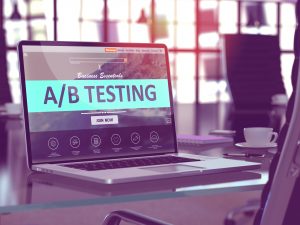Everyone from marketers, professionals, and salespeople agree that split testing is the most effective yet simplest ways to increase your landing page conversion rate.
Also known as A/B testing, split testing allows you to compare two different versions of the same page so as to enable you to know which of the two performs better with the aim of improving conversions. Usually, there’ll only be a single difference between the pages.
For instance, let’s assume you want to know if tweaking the headline on your landing page would lead to better conversions. After you direct traffic towards both landing pages, you realize that the page with the tweaked headline produced more conversions than the original. Since all you did was to change the headline on the landing page, you can be sure that the landing page was what led to increased conversions.
Unfortunately though, this takes a really long time as you’d have to change each and every element on the landing page to optimize it to near perfection.
So, how can we split test without compromising on effectiveness while taking a short time?
Imagine this, you want to increase your landing page’s conversions so you decide to make the following changes:
- Modify the headline
- Modify the call to action
- Modify the contact details form to have less fields
After running traffic to both the original and variation landing pages, your realize that the variation is performing far much better. However, you don’t know what actually led to the increase in traffic.
Factors You Need To Be Familiar With Before You Start Split-Testing
- Don’t Follow Blindly
Most people make the mistake of replicating split testing studies they come across in the course of their research. There’s one big problem though. The study you’re replicating may not have been conducted on the same demographic as yours, the offer might be different and the business model might be different.
Instead you should endeavor to come up with your own data. Take advantage of the many tools out there that can provide you with insights from heat mapping data, to customer surveys and analytics software. These will give you some factual information regarding where your landing page is falling short.
- Implement Best Practices
There are some generally accepted facts in the industry. For instance, it’s a well-known fact that landing pages shouldn’t have a navigation bar as doing so provides your users with multiple exits off your landing page. So instead of testing this out, just implement a universal truth in the marketing world and spend your time testing other elements of your landing page whose data is still unknown.
- Only Test Those Things That Will Increase Your Conversion
Even though it would be awesome to understand the role and contribution of each element on your landing page, marketers rarely have enough time or resources to conduct such expansive split tests. I’m assuming that you’re like most companies and don’t have bottomless pockets to fund your split tests. In which case you should only focus on testing big changes.
- Split Testing Can Only Get You So Far
Sometimes, the reason why you aren’t getting as many conversions as you want is because your website doesn’t receive enough traffic. Imagine this, you have a landing page with a 15% conversion rate, however you only send 100 people to the site and so only 15 people convert. Even if you were to continue optimizing your landing page and say were able to bring the conversion rate to 25% that wouldn’t be an optimum percentage.
However, if you decided to send 1,000 people to your landing page and maintained the 15% conversion rate that means you’re able to sell your brand to 150 people.
How To Conduct Split Tests For Landing Pages
Here are a couple of things you need to do when doing a split test.
Test For A Reason
You shouldn’t just run split tests for no reason or because it seems trendy, instead your decision should be based on hard data. Perhaps the numbers on Google Analytics indicate that people are spending an average of 6 seconds on your page before they leave.
It might be that there’s a mismatch between your landing page and ad or perhaps your headline doesn’t do a great job of grabbing attention which is why they’re leaving in the first place. But whatever the case you need to have a solid reason for doing a split test so that you can set your objectives.
Statistical Significance
Statistical significance refers to the number of users who’ll have visited your page before you’re confident regarding your results.
The statistical significance that is commonly accepted is 95%. What this means is that by the time you end your tests, there only should be a 5% possibility that your results are a coincidence. The level of significance of 95% indicates that you’re 95% confident that the spike you’ve witnessed in the conversion rate is due to the changes you’ve made.
Tools such as Optimizely, can help you determine the level of statistical significance instead of doing the mathematical equations yourself (which can get quite complicated).
Creating Variations
Now that you’ve identified the changes you need to make on your landing page, it’s time to create a variation version of your landing page and tweak the elements you identified. There are tools you can use to create variations such as Instapage.
Remember not to change anything on your original page if you do you’ll have an inaccurate baseline for testing.
Watch Out For Variables
Since split tests aren’t conducted in a vacuum, there’s a possibility that an external factor will affect your split test results in a big way and you’d end up with wrong data.
You need to keep an eye out for anything that could cause such errors including different ads and traffic sources.
You’ll have to stay alert during the entire duration of the split test not just at the beginning.
Ensure Everything Works
Before your test goes live, you should ensure that everything works. For instance, you should check to see how your landing page looks on every browser, are the links working? What about your CTA?
Double check every aspect of your landing page or all your hard work will have been for nothing.
Directing Users To Your Page
Unless you’re split-testing your ads, you should ensure that all your traffic is coming from one source. You should make sure that the traffic you send to your landing pages isn’t biased as that would give you wrong data. This is known as the selection effect.
An example would be, you send traffic consisting of your loyal email subscribers to your landing page even though you’re targeting average users. Since your subscribers already like you, they’ll be ok with your landing page. But this would be misleading as average users who don’t really know you or your brand might bounce right off the page once you make it the official page.
Would you like to consult on how to build an effective landing page for your business or would you like to consult on an existing one? Get in touch with us.




